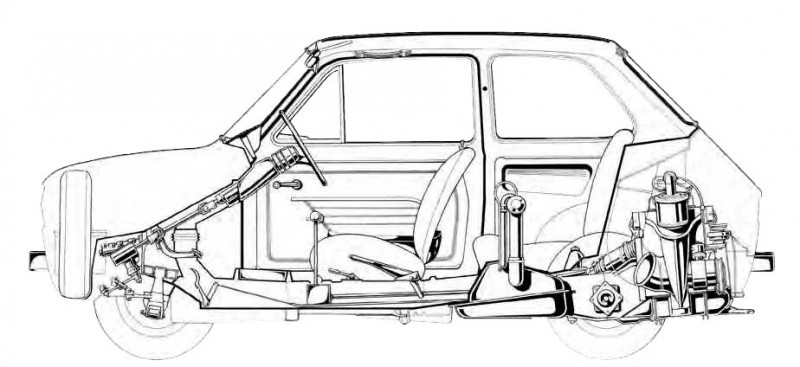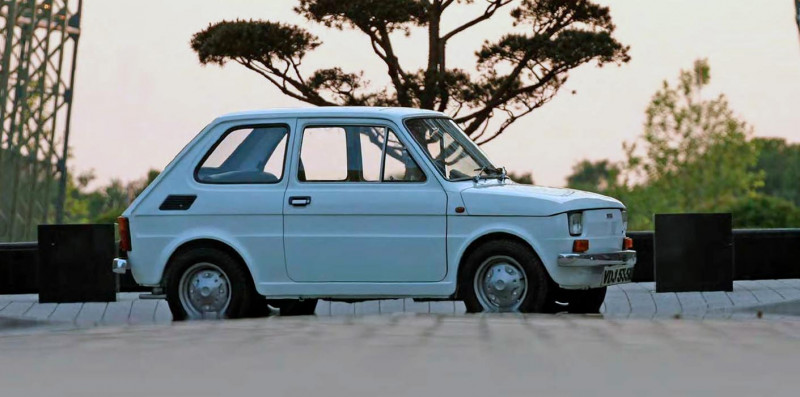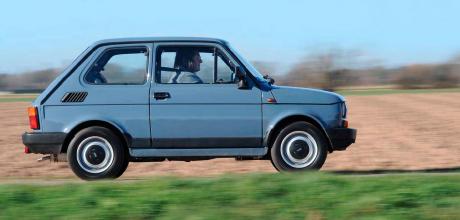Fiat 126 at 50
Fiat’s boxy 126 city car celebrates its 50th birthday this year. Often maligned, we argue the case for the perky, petite and – in its day – very popular 126. Story by Gary Axon. Photography by Michael Ward & Tony Harrison.
NIFTY AT FIFTY Fiat 126 at 50
Championing Fiat’s much maligned minicar
Since the introduction of Fiat chief engineer Dante Giacosa’s Fiat 500 ‘Topolino’ in 1936 – ultimately succeeded 21 years later by his cute and cult-like rear-engined Nuova 500 – bambino Fiats have been the very lifeblood of the Torinese marque. As if proof were needed, today’s retro 500 remains the mainstay of Fiat’s sales in most export markets, almost singlehandedly keeping the brand viable and afloat outside its native Italy.

Such was the 1957 Nuova 500’s success and popularity – and social importance in its home market, where it helped to put Italy on wheels in very tough post-war years – that the cute and curvaceous micro- Fiat was always going to be a tough act to follow. After 15 years and comfortably in excess of 3.5 million sales (including almost 330,000 Giardiniera estate derivatives), in 1972 Fiat bravely presented a new car: the 126. Although it was sold alongside the Nuova 500 for three years, it was always meant to be its successor. The crisp new boxy shape was styled by ex-Ghia and OSI designer, Sergio Sartorelli, who was also the author of the edgy Volkswagen Karmann-Ghia Type 34 and the OSI-Ford 20M Coupe, as well as Fiat’s 2300 S Ghia Coupe and, later, the daring Ritmo/Strada. The 126 retained the 500’s air-cooled, rear-engined configuration, but with more square-cut styling that echoed contemporary Fiat models such as the larger 127 and 128.

The 126 was initially introduced in parallel to a mildly revamped version of the 500 called the 500 R, to keep loyal and cautious customers on board – those who might have been reluctant to accept the new-fangled 126. The reworked 500R (‘rinnovata’ or ‘renewed’) model shared the then-new 126’s sportier hubcap-free wheels and increased engine capacity of 594cc. But while the 500R developed just 18hp, the 126 had a whopping 23hp.
As well as looking more modern than the 500, the 126 was also marginally bigger and more spacious (although still no match in packaging terms for the BL Mini, as made in Italy by Innocenti). The 126 met with encouraging early acceptance and healthy sales following its late 1972 debut – unlike the 1957 Nuova 500, which took a surprisingly long time to be accepted after the conventional 500 Topolino. The 126 was launched at just the right time, as the oil crisis engulfed the world and the car’s amazing fuel economy proved perfect for the market.
In 1975 came the option of an opening sunroof. Then in 1977 came a moderately improved range, the most significant change being an enlarged 652cc motor developing 24hp. A plusher Personal 4 model also joined the range, marketed as the De Ville in the UK, and Bambino in selected mainland European markets. This was identifiable by its revised wheels and anodised bumpers replacing the original chrome-plated units. A series of late-1970s special editions then followed to boost the baby Fiat’s appeal, such as the colour-themed Silver, Black, Red and Brown models.
Some wags joked that the colour scheme of earlier models soon became brown through excessive corrosion… These ‘colour’ editions had the novelty of a standard miniature slot-in radio for British buyers, with red, green and blue FM, LW and AM frequency ranges. Fiat buoyed up its western European sales with production also briefly taking in Greece and Austria (the latter by Steyr in Graz, using its own livelier Puch engine, as found in earlier Austrian Fiat 500-based models). In the Eastern Bloc, 126 production commenced briefly at Fiat’s Yugoslavian Zastava facility. But far more success awaited Fiat’s affiliated Polish Tychy plant in Bielsko-Biala. The Fabryka Samochodow Malolitrazowych (FSM) works produced the 126 as smaller sibling to its 125p and Polonez models. Branded as the Polski-Fiat 126p, this little car quickly won the hearts and minds of car-starved Poles, becoming something of a cultural icon as the nation’s ‘peoples’ car. It was affectionately nicknamed ‘Maluch’, the Polish for ‘Toddler’ or ‘Little One’, a name that FSM recognised by adopting it officially for its badging during the 1980s.
In 1980, Fiat ended 126 production in Italy after 1,352,912 examples had been made. The more cost-effective FSM Polish factory then supplied the model globally, helping to keep this entry model extremely affordable (in 1980, for instance, the 126 cost £2008 in the UK, compared to £2404 for the Mini City). Build quality did suffer somewhat, with poor-fitting doors in particular being difficult to close, resulting in the UK Fiat importer setting up a dedicated pre-delivery dismantling and reassembly facility at its English dockside preparation centre.
By 1987, the maturing 126 underwent another refresh to create the ‘Bis’ model. This long-overdue facelift included the crucial addition of an opening rear hatchback and foldable one-piece rear seat. This was made possible by canting over the enlarged 704cc engine to facilitate a lower load platform. The newly catalysed motor now had water rather than air cooling for the first time and developed a ‘mighty’ 26hp. The 126 Bis continued in this final guise in many markets, including the UK and, briefly, Australia (as the FSM Niki).
In most countries, the 126 was replaced by the all-new Polish-built Fiat Cinquecento from 1993. However, the 126 continued in Poland right up until 2000, latterly branded as the Pop, with the last 1000 run-out models badged – somewhat amusingly – as the 126 Happy End, of which 500 were painted red and 500 yellow. By the end, a remarkable 3,318,674 examples of the 126 had been built in Poland, of which around 880,000 were Bis derivatives.
For 126 buyers seeking additional power, soon after launch, the renowned Italian Fiat tuner Giannini offered a selection of more potent packages, including the 594cc/29hp GP, 694cc/33hp GP S and 794cc/39hp GP A. Others included the Francis Lombardi 126 Sport with 30hp, and the ‘luxury’ Fissore 126 Lusso. Conversely, in Germany, frugal and motorists aged as young as 16 could opt for a tiny 245cc ex-Glas Goggomobil motor, limited to a top speed of 56mph (90km/h). The socalled 250L was made and sold by Steinwinter of Stuttgart during the 1980s.
Ahead of its 1972 launch, Fiat itself ‘previewed’ a few of the 126’s components (wheels, doors and glass) in its black rubber-nosed ESV 1500 safety concept vehicle of 1971, with the 126 base was also used for Fiat’s one-off 1975 Cavaletta prototype beach car. In Italy, local Fiat 126 spin-offs and specials mostly concerned micro-jeeps and beach buggies like the Scoiattolo, Savio Jungla, Auto Mirage Pick Wick, Moretti Minimaxi and All Cars Amigo (the latter also marketed by Steinwinter, replete with Ferrari-esque prancing horse badges!). Closer to home, British 126-based self-assembly kit cars included the pleasing X1/9-esque MCA/Dash Coupe, the Foulkes Impala jeep, Vignale Gamine-inspired Sun replica, plus the funky CC Zero buggy.
In its adopted Polish homeland, Polski-Fiat/FSM 126 oddities included an official front-engined/frontwheel drive prototype that used many Cinquecento parts, plus experimental diesel power, as well as an estate and two-seater box van variants. There were also numerous Pop convertibles and home-made specials, including stretched four-door and snow-plough applications!
So, a ‘Happy End’ to what, perhaps surprisingly, remains the fifth best-selling Fiat (and therefore Italian car) of all time. Indeed, with total production of 4,673,655 examples over a 28-year long career, the 126 outsold both the Fiat 500 and 600. According to the HowManyLeft website, some 242 examples are still licensed in the UK. Happy 50th birthday, Fiat 126. You don’t look a day over 49!
Yes, they really did call the run-out edition of 2000 the ‘Happy End’! 500 red and 500 yellow were made.
Simplicity personified in this superb, low-mileage Polish-built FSM 126, owned by the Sever family.
ABOVE: Tiny twin-pot engine. LEFT: Launch car from 1972.
SECOND ROW: Fiat emphasised 126’s usability; FSM’s Bombel pick-up prototype never progressed; 126 Bis had water-cooled power and hatchback.
THIRD ROW: Late-1970s Black, Silver and Brown editions.
BOTTOM ROW: Giannini 800 was a real firecracker; Moretti built the Minimaxi ‘jeep’; Bosmal convertible was built in Poland


